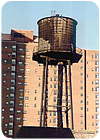
For years, the gravity tank has graced urban skylines, housing water and harnessing an energy known as simple gravity. Nowhere else are these tanks so prominent or seen in such high concentration as they are in New York City, where they have fed standpipes and fire sprinklers since the 1920s. Thousands remain today in the Big Apple. Prior to the proliferation of fire pumps, the wooden rooftop water tanks were long considered the first line of defense against high-rise building fires. They ensured both an adequate quantity of water and adequate pressure.

Hidden From View
Many tanks go unseen by passersby-they are housed inside the building on its uppermost floor or penthouse. Water pumped up to fill the tanks is gravity fed down through 6" or 8" pipe, normally to a shutoff valve in the basement, and then upwards to the standpipe, which feeds fire hose valves and sprinkler systems. A pressure tank in a heated area is used as a backup. The first fire sprinkler that flows is always pressurized.This simple methodology remains the most efficient means to supply consistent water pressure. Once the tank is filled, it offers fire protection without interruption due to power failure or mechanical breakdown. In remote areas where water is not accessible, tanks fed from wells stand as a dependable water source.
In colder climates, what keeps this enclosed tank from freezing is its large mass of water and any small flows that occur. Exposed connecting pipe that is vulnerable to the atmosphere may require heat tracing. An annual inspection during the autumn months should include a tank examination to determine if adequate protection against freezing has been maintained and that any heating system employed is still in peak operating condition.
While wood doesn’t crack in the event of a freeze-up, pipe and fittings will. It is imperative that heating equipment allow reliable operation to 50°F. Any overheating can damage a wooden tank. The exterior access ladder should be periodically checked for stability, and the NFPA requires a 5-year check of the tank interior for any possible collection of debris. In areas subject to seismic activity, the tanks are to be designed for earthquake protection.
A unique quality of wooden gravity tanks is their inherent thermal ability to protect water from freezing. Natural and non-corrosive, the cellular makeup of wood serves as an efficient insulator. Cedar planks are often used for construction of the tank walls and floors because of their resistance to mold and rot. The planks, normally 2-5/8" thick, have the insulation equivalent of a 28-inch concrete wall. Some of the older tanks were constructed with 3-1/2" thick walls. These tanks, taken down after 100 years of service, have shown little (1/16" inch) or no evidence of rotting.
Gravity tanks are extremely heavy, supported by steel towers above strong structural columns built around the building elevators. The wall construction of the tanks consists of wood “staves” that are between 15 and 20 feet long. They are banded together with tightened 1/2" steel rods or “hoops,” a process similar to wooden barrel-making. There is no glue-leakage is prevented by the pressure exerted by the galvanized hoops combined with the swelling properties (like an old boat) of the wood when wet.A double-sided metal sign adorns each tank, which provides information such as the manufacturer, date constructed, tower height in feet, tank diameter, stave length and gallon capacity. Gravity tanks range in capacity from 5,000 to 75,000 gallons. If built today, a 10,000-gallon wooden tank will cost in the vicinity of $30,000.
Gravity tanks dot rooftops in virtually any large industrial city (and some rural towns) east of the Mississippi. Some that can be seen today are actually “dead soldiers”-just a steel stand with an empty tank. Many are used as billboards, but they do present a safety hazard if not kept full of water. Rotting becomes a problem if they are dry. If they remain in place, varnish and wood preservatives are used, and towers must be beefed up structurally. The steel hoops must be nailed in place to prevent them from falling, as the wooden staves begin to shrink.
Tank-Grade Wood
Cedar is a readily available wood. Any pencil you pick up is made of cedar. But most gravity tanks were constructed of redwood (from coastal California or China) or cypress (from U.S. southern swamps). The taller redwoods have a longer cell structure than the cypress, which has harder fiber and a longer life as a tank-easily lasting 100 years. Wood from these trees represents the highest grade of wood, which today is known as “tank grade.”This wood has no knots, and comes from old, slow-growth trees with long trunks, some of which spanned 10 feet in diameter. You cannot count the trunk rings because they are so close together. When gravity tanks are removed (roughly a $5,000 endeavor), the remaining wood won’t go to a landfill because it is in hot demand from woodcarvers and sign makers. They will pay up to $3,000 for the high-grade wood from a single tank.
There are about 200 gravity tanks still servicing Chicago buildings, and fire
sprinkler contractors can expect a call when there’s a problem. These are
typically freeze-ups in the 2" filler line or a circulating hot water line
that didn’t get drained. Or an ice plug may form in the service riser. Or a
rupture will occur between the roof and the underside of the tank if a heater
failed to run, and the result is a pretty big mess.
But all is repairable, and a simple service call is all it takes for the entire
system to be back up and running, and that is big news lately in Chicago. Last
July, their city council unanimously passed an ordinance to keep gravity-fed
wooden water tanks from being haphazardly torn down. The ordinance imposes a
90-day demolition delay on all gravity tanks, a time frame that the city can
extend at its discretion.
New York has made no such rescue efforts. The spokeswoman for the NYC Landmarks
Preservation Commission, Elisabeth DeBourbon, has stated: “we only designate
entire buildings as landmarks. We don’t designate features of buildings.”
For combination sprinkler/standpipe systems, water pressure (provided entirely
by gravity) is determined by the height of the tank above the particular floor
of sprinklers. If you need 15 psi at the highest fire sprinkler, then the
tank’s water level must be 35 feet above that sprinkler. The gravity tank is
vented and requires no amenities other than a level switch or float valve
(inside the tank), which sends a signal to a domestic pump in the basement to
lift water into the tank until it is filled.
The greater the pump capacity, the shorter the time needed to refill the pump.
A second float valve near the top of the tank serves as the domestic pump
shutoff. The tank also contains a roof hatch with access to an inside
maintenance ladder. Installation of new tanks must conform to requirements
outlined in NFPA 22, Standard for Water Tanks for Private Protection.
In addition to fire pumps, what has put an end to new installations of gravity
tanks are concerns regarding maintenance, structural integrity and the
reluctance of employers to have anyone working at high elevations. No one, it
seems, wants a new gravity tank. But while they appear to be artifacts of a
bygone era, those still in service provide an essential fire protection and
life-safety service. In New York City, assuredly the last vestige for gravity
tanks, it is estimated that wooden tanks are present in 90% of structures more
than six stories high.But they won’t last forever. The redwood tanks,
particularly those harvested of wood from China’s east coast, have a projected
50-year life expectancy. Many of those were erected in the 1950s and will be
the next to go. And they will be missed.